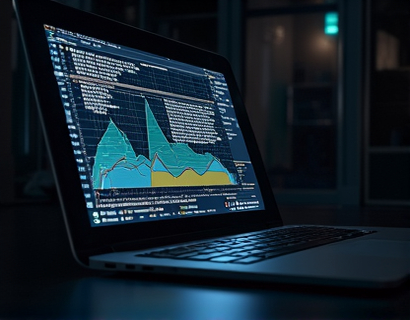Maximizing Digital Asset Value: Leveraging Smart Contracts for Long-Term Locking and Sustainable Fintech Growth
The digital finance landscape is undergoing a transformative shift, driven by innovative technologies and collaborative efforts aimed at fostering sustainable growth. One of the key strategies in this evolution is the use of smart contracts to securely lock in digital assets like UCASH for long-term incentives, thereby ensuring sustainable fintech development. This approach not only maximizes the value of digital assets but also builds a robust and thriving community centered around transparent incentives and long-term value creation.
Smart contracts, self-executing contracts with the terms directly written into code, offer a unique solution for managing digital assets. By automating the execution of agreements, they eliminate the need for intermediaries, reduce transaction costs, and enhance security and transparency. In the context of digital finance, smart contracts can be utilized to lock assets for specified periods, ensuring that investors receive consistent and predictable returns over the long term.
The concept of locking digital assets for long-term incentives is rooted in the principle of providing stakeholders with guaranteed returns while contributing to the overall health and growth of the ecosystem. This strategy is particularly beneficial for digital assets like UCASH, which are designed to offer holders various incentives and rewards. By using smart contracts to lock these assets, users can secure their investments and benefit from a structured and reliable system that promotes sustainable growth.
One of the primary advantages of this approach is the enhancement of transparency. Smart contracts operate on blockchain technology, which provides an immutable and transparent ledger of all transactions. This means that every lock, unlock, and transfer of assets is recorded and verifiable by all participants in the network. Such transparency builds trust among users, encouraging more participation and investment in the ecosystem.
Reliability is another critical factor. Smart contracts are programmed to execute precisely as intended, without room for human error or manipulation. This ensures that the terms of the agreement are upheld consistently, providing investors with a high level of confidence in the system. The automation of these processes also reduces the risk of fraud and errors, further enhancing the reliability of the platform.
The use of smart contracts for long-term asset locking also fosters a more equitable distribution of rewards within the ecosystem. By automating the allocation of incentives, the system ensures that all participants receive their due rewards based on predefined criteria. This eliminates the potential for bias or favoritism, creating a fair and inclusive environment that encourages active engagement and long-term commitment from all stakeholders.
Moreover, this approach contributes to the overall sustainability of the fintech ecosystem. By locking assets for extended periods, the platform can reinvest a significant portion of the funds into the development of new features, improvements, and community initiatives. This reinvestment cycle creates a positive feedback loop, where the growth of the ecosystem leads to increased value for all participants, further attracting new investors and users.
To illustrate the benefits of this strategy, consider the following scenario: an investor locks a certain amount of UCASH using a smart contract for a period of one year. During this time, the platform uses the locked assets to fund various projects and initiatives, such as enhancing the user interface, developing new features, and expanding the community through educational programs. At the end of the lock period, the investor receives their assets back, along with the agreed-upon incentives, which could include additional UCASH tokens, access to premium services, or other forms of rewards.
The process begins with the user initiating a smart contract to lock their UCASH. The contract specifies the duration of the lock, the terms of the incentives, and the conditions for unlocking the assets. Once the contract is deployed, the assets are securely held in a smart contract wallet, accessible only through the terms defined in the contract. The platform then proceeds with the planned activities, ensuring that the locked assets contribute to the ecosystem's growth.
Transparency plays a crucial role in this process. All stakeholders can monitor the status of the locked assets and the progress of the funded projects through the blockchain ledger. This real-time visibility not only builds trust but also allows users to make informed decisions about their investments. The immutable nature of the blockchain ensures that once the contract terms are met, the unlocking process is automatic and tamper-proof, further enhancing the reliability of the system.
The long-term benefits of this approach extend beyond individual investments. By fostering a community that values transparency, reliability, and sustainable growth, the ecosystem creates a virtuous cycle of development and innovation. As more users join and contribute, the platform gains more resources to invest in new projects and improvements, attracting even more participants. This continuous cycle of growth and reinvestment ensures that the ecosystem remains dynamic and resilient, capable of adapting to changing market conditions and technological advancements.
Furthermore, the use of smart contracts for asset locking aligns with the broader goals of sustainable fintech development. By prioritizing long-term value creation over short-term gains, the platform promotes a responsible and ethical approach to digital finance. This focus on sustainability not only benefits the current users but also sets a positive example for the industry as a whole, encouraging other fintech companies to adopt similar practices.
In conclusion, leveraging smart contracts for long-term locking of digital assets like UCASH offers a robust solution for maximizing value and fostering sustainable growth in the fintech sector. The combination of transparency, reliability, and equitable incentive distribution creates a strong foundation for a thriving and resilient ecosystem. By joining this movement, investors and users can contribute to a future where digital finance is characterized by innovation, collaboration, and long-term prosperity.









































